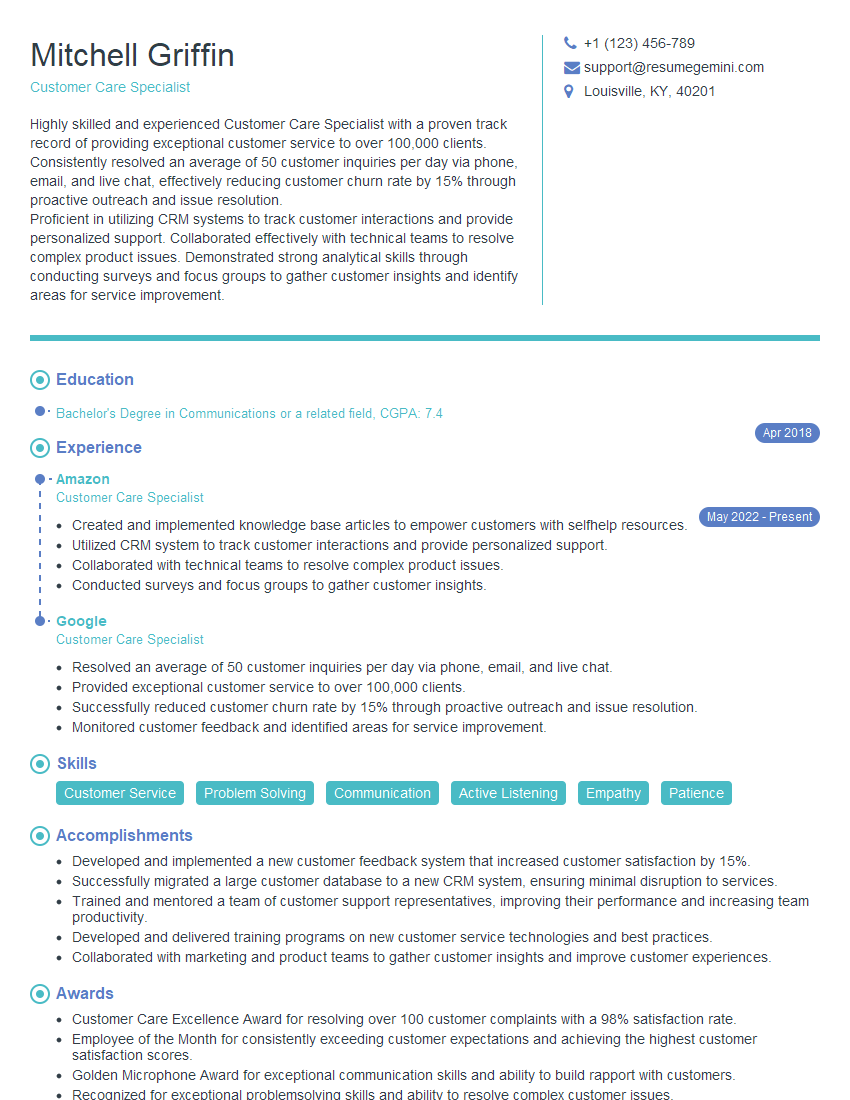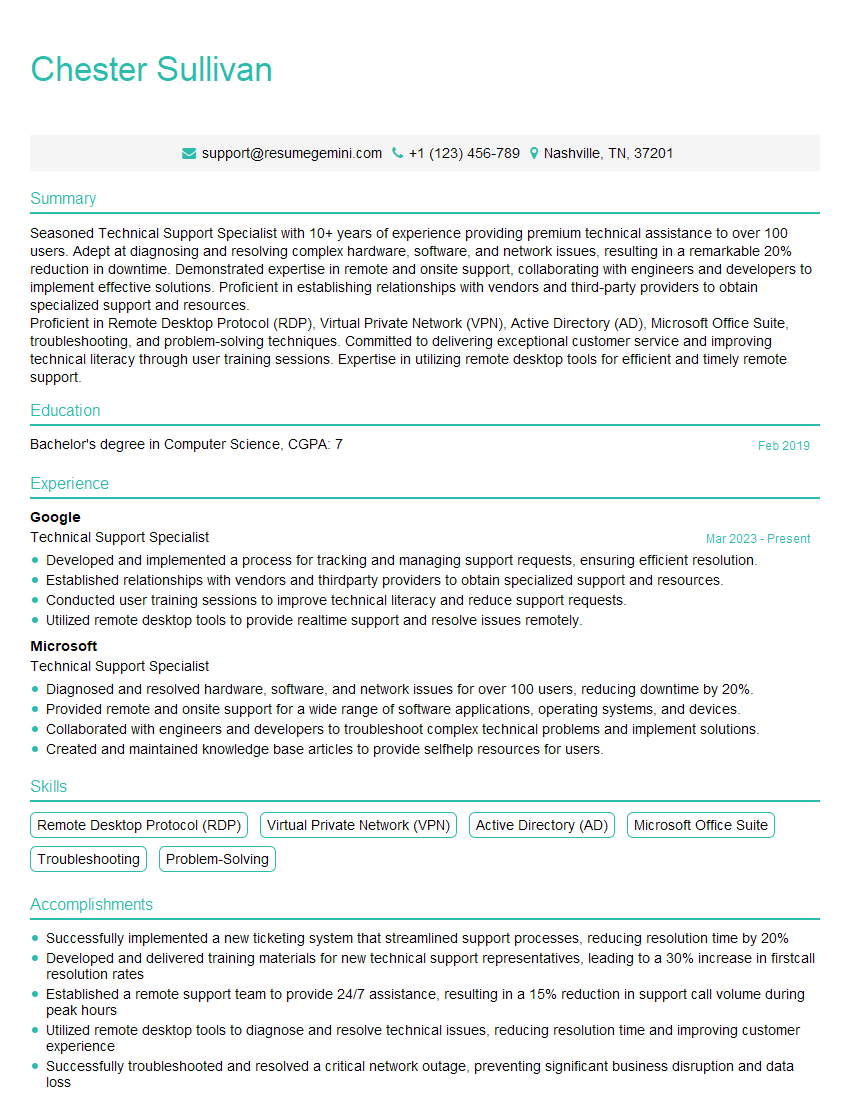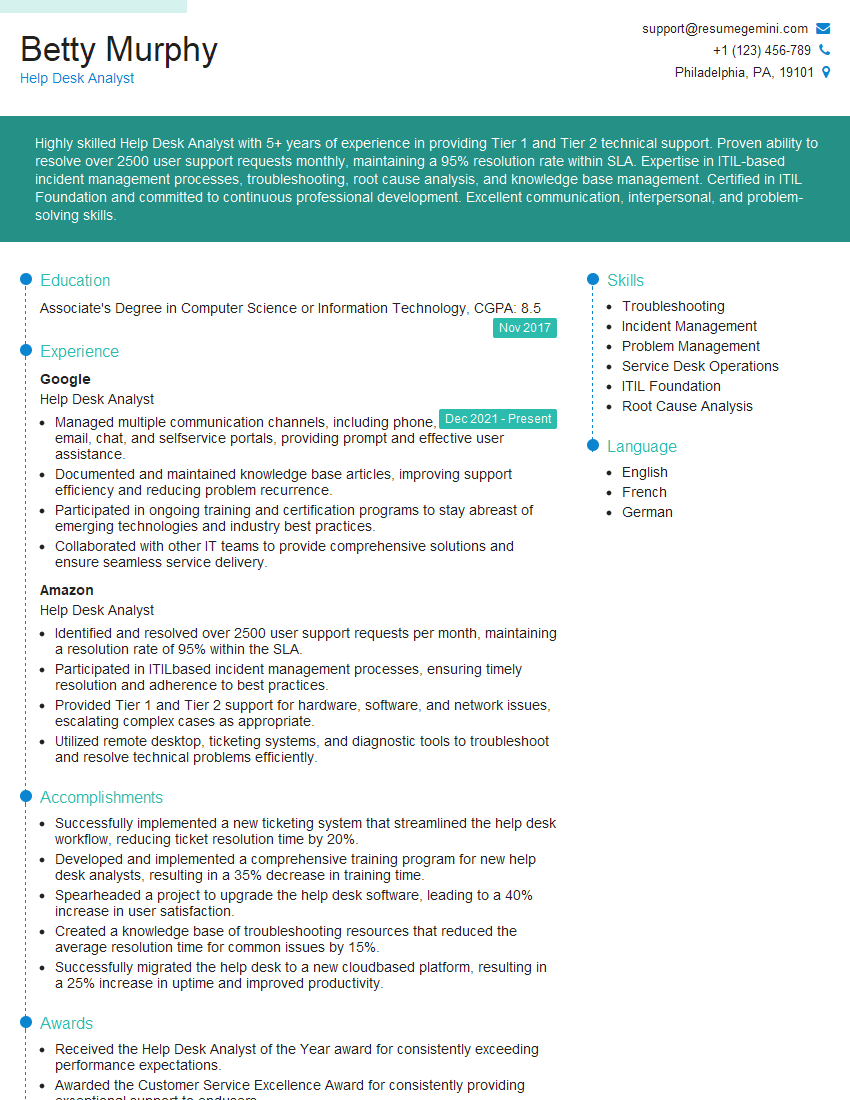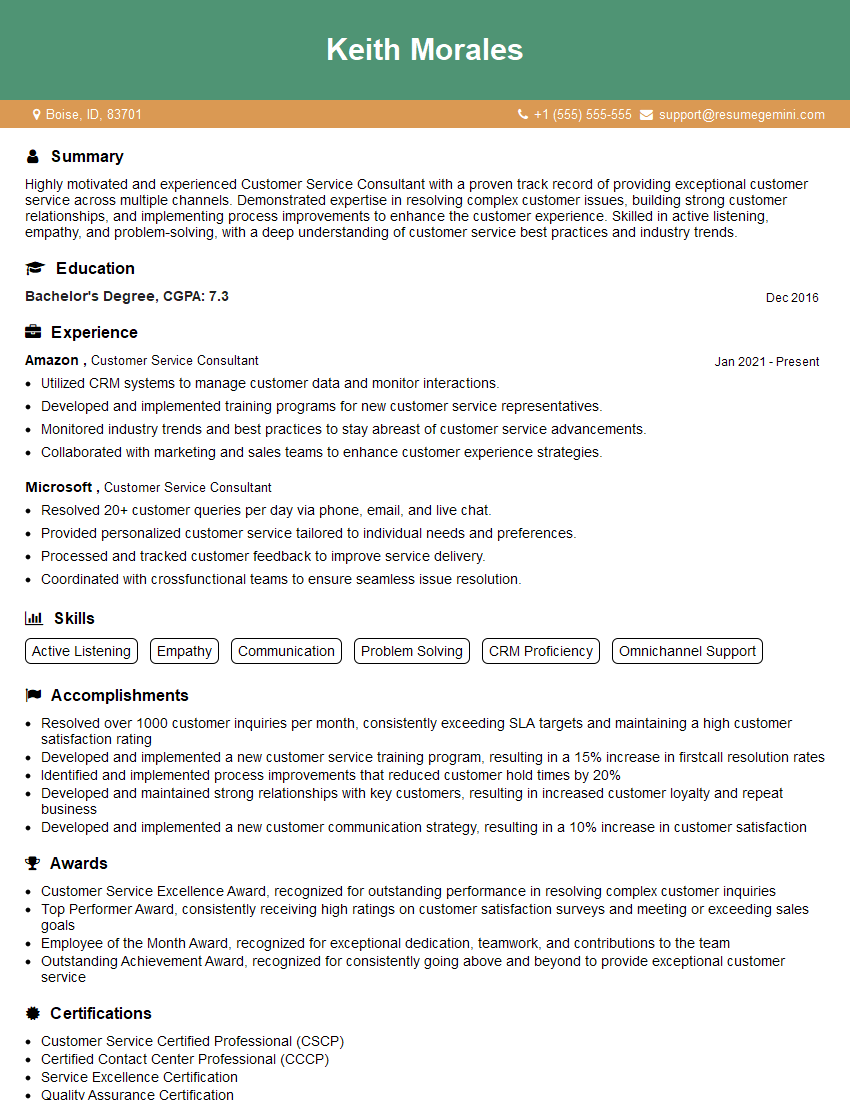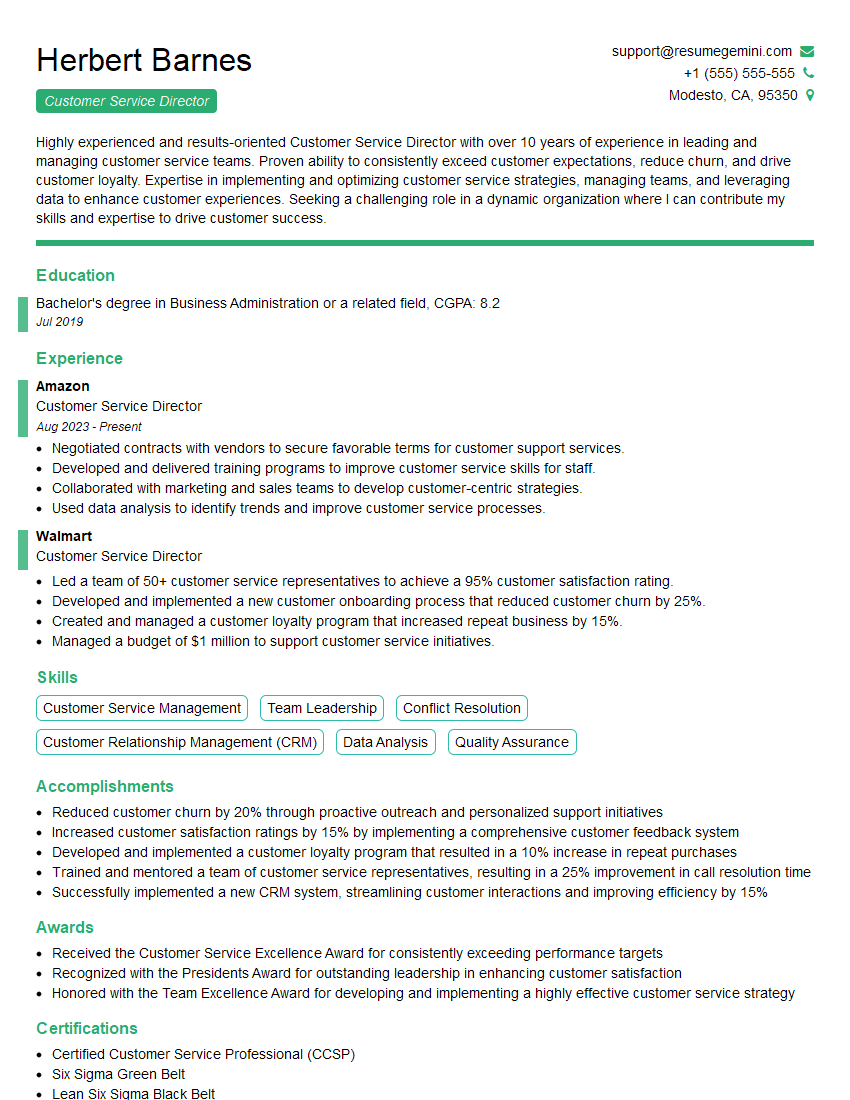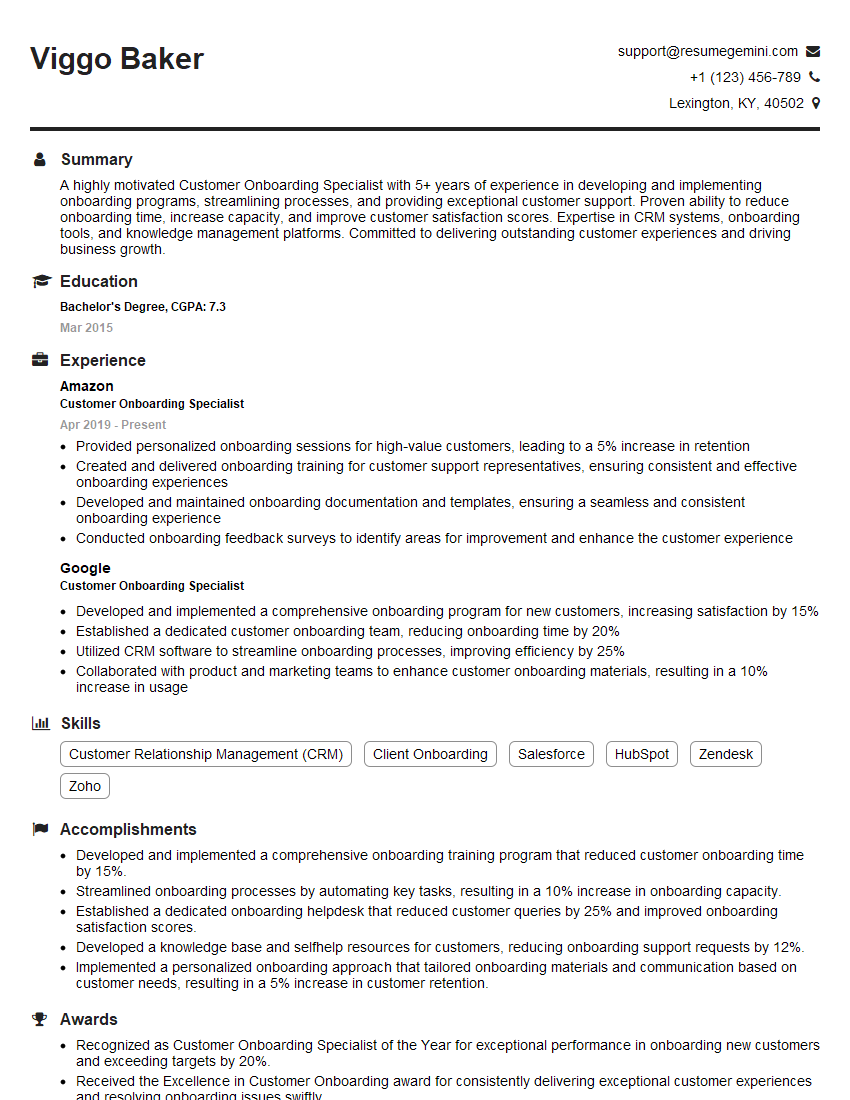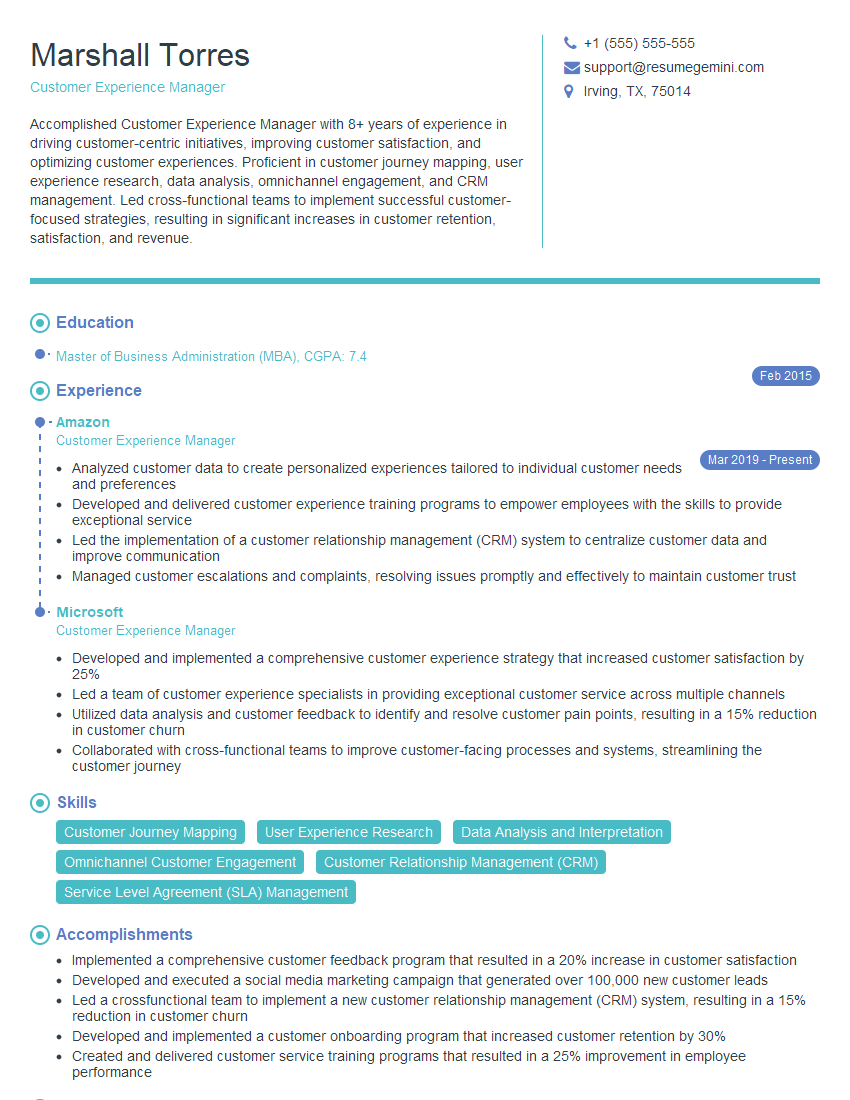Feeling uncertain about what to expect in your upcoming interview? We’ve got you covered! This blog highlights the most important Certified Customer Care Professional (CCCP) interview questions and provides actionable advice to help you stand out as the ideal candidate. Let’s pave the way for your success.
Questions Asked in Certified Customer Care Professional (CCCP) Interview
Q 1. Describe your experience handling challenging customer interactions.
Handling challenging customer interactions is a cornerstone of excellent customer service. My approach involves active listening, empathy, and a structured problem-solving methodology. I start by letting the customer fully express their concerns without interruption, ensuring they feel heard and understood. This often involves using verbal cues like ‘I understand your frustration’ or ‘Let me see if I can help you with that.’ Then, I carefully analyze the issue, clarifying any ambiguities, and identifying the root cause. I’ll often summarize the problem back to the customer to confirm my understanding. Finally, I collaboratively work with the customer to develop a solution, clearly outlining the steps involved and managing their expectations. For instance, if a customer is angry about a delayed shipment, I wouldn’t immediately jump to offering a refund. I’d first investigate the delay, provide a realistic timeline for resolution, and perhaps offer a small gesture of goodwill, like expedited shipping for their next order, to demonstrate my commitment to their satisfaction.
Q 2. Explain your understanding of the CCCP certification and its core principles.
The Certified Customer Care Professional (CCCP) certification demonstrates a high level of competency in providing exceptional customer service. Its core principles revolve around building strong customer relationships, understanding customer needs, and resolving issues efficiently and effectively. The certification emphasizes proactive communication, problem-solving skills, and the ability to handle difficult situations with professionalism and composure. Key principles include active listening, empathy, conflict resolution, and understanding different communication styles. It’s not just about resolving immediate issues; it’s about creating a positive and lasting impression, fostering loyalty, and contributing to the overall success of the business. The CCCP certification provides a framework for consistently delivering outstanding customer experiences.
Q 3. How do you prioritize multiple customer requests simultaneously?
Prioritizing multiple customer requests requires a strategic approach. I use a system that combines urgency, impact, and customer value. I employ a triage system – assessing each request based on its severity and the potential impact on the customer and the business. Urgent issues, such as a critical system failure impacting many customers, take precedence. I then prioritize requests based on their impact on customer satisfaction and loyalty. A high-value customer with a complex issue might require more immediate attention than a less critical query from a new customer. Using effective time management techniques, such as time blocking and task prioritization tools, allows me to allocate my time effectively. I also communicate with customers to manage expectations, letting them know when they can anticipate a response. For example, I might say, ‘I’ll address your question within the next 30 minutes,’ while simultaneously handling a more urgent issue.
Q 4. What techniques do you use to de-escalate angry or frustrated customers?
De-escalating angry or frustrated customers requires patience, empathy, and skillful communication. My approach begins with active listening – letting the customer vent their frustrations without interruption. I use verbal cues to show that I understand their feelings, such as, ‘I can hear how upset you are,’ or ‘I understand your frustration.’ I then try to validate their feelings by acknowledging their perspective. Once the customer has calmed down, I collaboratively work towards a solution, ensuring they are involved in the process. I remain calm and professional, avoiding defensive language or interrupting the customer. If the situation remains tense, I might offer a small concession, such as a discount or expedited service, as a gesture of goodwill. The goal is to turn a negative experience into a positive one, reinforcing their trust in the company.
Q 5. Describe a time you went above and beyond for a customer.
In a previous role, a regular customer experienced a significant technical issue just before a critical deadline. The standard troubleshooting steps weren’t resolving the problem, and the customer was understandably panicked. Instead of simply following standard procedures, I stayed late to work with the engineering team to diagnose the problem remotely. We finally identified a rare software bug. While the fix required a software update, we ensured a seamless transition with clear communication to the customer throughout the process, providing interim workarounds to minimise disruption. By going above and beyond, I not only solved the immediate issue but also strengthened my relationship with the customer, earning their loyalty and resulting in positive word-of-mouth referrals.
Q 6. How do you handle customer complaints effectively?
Handling customer complaints effectively involves a multi-step process. First, I listen attentively to the customer’s complaint, ensuring I fully understand their perspective. I then empathize with their situation, acknowledging their feelings. Next, I apologize sincerely, even if I’m not personally responsible for the issue. Then, I investigate the complaint thoroughly, gathering all relevant information. Once I understand the root cause, I collaboratively work with the customer to find a fair and reasonable resolution. This might involve offering a refund, replacement, repair, or other forms of compensation. Finally, I follow up with the customer to ensure they are satisfied with the outcome and to prevent similar issues from happening again. Documentation of the entire process is crucial for improving future service and identifying systemic issues.
Q 7. What metrics do you use to measure customer satisfaction?
Measuring customer satisfaction involves using a range of metrics. Key metrics include Customer Satisfaction (CSAT) scores, obtained through surveys or feedback forms; Net Promoter Score (NPS), which measures customer loyalty and willingness to recommend; and Customer Effort Score (CES), which assesses the ease of doing business with the company. Other important metrics include average resolution time, first call resolution rate, and customer churn rate. Analyzing these metrics provides valuable insights into customer experience and allows for continuous improvement. By regularly monitoring these metrics and identifying trends, we can proactively address areas for improvement and enhance the overall customer experience.
Q 8. How familiar are you with different customer service channels (phone, email, chat)?
My experience encompasses all major customer service channels – phone, email, and chat – each demanding a unique approach. Phone calls allow for immediate interaction and empathetic tone adjustments; email provides a documented record and allows for more considered responses; and chat offers the speed of a phone call with the written record of an email. I’m adept at using the appropriate channel depending on the customer’s needs and the complexity of the issue. For instance, a complex technical problem might necessitate a phone call for immediate troubleshooting, while a simple order update can be efficiently handled via email or chat. I’m proficient in managing multiple channels simultaneously, prioritizing urgency and ensuring no customer is left unattended.
Q 9. How do you identify and resolve recurring customer issues?
Identifying and resolving recurring customer issues involves a systematic approach. First, I meticulously track all customer interactions, noting common complaints or problems. Tools like CRM software are invaluable here. Once patterns emerge, I analyze the root cause. Is it a product defect? A gap in training for staff? A poorly written instruction manual? Addressing the root cause is crucial. For example, if numerous customers complain about a specific feature’s difficulty, I would work with the product development team to improve its usability or create more helpful documentation. Finally, I implement solutions and monitor their effectiveness, tracking customer feedback to ensure the problem is genuinely resolved. Regular reporting to management on these recurring issues and their resolution keeps everyone informed and proactively prevents future problems.
Q 10. Describe your experience using customer relationship management (CRM) software.
I have extensive experience with various CRM systems, including Salesforce and Zendesk. My expertise extends beyond basic data entry; I understand how to leverage these systems for efficient customer service. I utilize CRMs to track interactions, manage cases, identify trends, and personalize customer interactions. For example, I can access a customer’s previous interactions to provide a seamless and informed response, reducing wait times and enhancing customer satisfaction. Furthermore, I’m proficient in using CRM reporting features to identify key metrics such as average resolution time, customer satisfaction scores, and areas needing improvement, helping us continuously refine our service strategies.
Q 11. How do you stay updated on the latest customer service best practices?
Staying current on best practices is paramount in customer service. I actively engage in professional development through several avenues. I regularly read industry publications and blogs, attend webinars, and participate in online forums dedicated to customer service. Furthermore, I actively seek out and participate in training sessions offered by my employer and professional organizations focused on improving customer service skills. I also actively seek out customer service excellence awards and case studies to understand leading practices within the industry. Networking with other customer service professionals through conferences and online groups further enhances my understanding of emerging trends and innovative techniques.
Q 12. How would you handle a situation where a customer’s request is outside your scope of responsibility?
When a customer’s request falls outside my purview, my priority is to ensure they receive the necessary assistance. I would first empathize with their situation and explain that I am unable to directly address their issue. Then, I would carefully identify the appropriate department or individual who *can* help and initiate a transfer or escalation. This process might involve creating a ticket in the internal system or forwarding the email to the correct team. I would actively follow up to ensure the customer’s problem was properly handled, keeping them informed of progress. This demonstrates professionalism and ensures the customer doesn’t feel abandoned.
Q 13. Explain your understanding of customer service ethics and professional conduct.
Customer service ethics and professional conduct are the foundation of my work. This includes maintaining confidentiality, treating all customers with respect and courtesy regardless of their demeanor, being honest and transparent in my interactions, and adhering to company policies and procedures. I understand the importance of unbiased service and never discriminate based on personal characteristics. Additionally, I am committed to continuous improvement, always striving to provide exceptional service while upholding the highest ethical standards. For example, I would never share a customer’s personal information without their explicit consent.
Q 14. What is your approach to building rapport with customers?
Building rapport with customers is a key element of successful customer service. I begin by actively listening to understand their concerns, demonstrating empathy and validating their feelings. I use their name throughout the conversation and strive for a friendly, conversational tone. I also personalize interactions where appropriate, using information from the CRM system to tailor my approach. A simple technique is to mirror their communication style; if they’re concise, I’ll be concise. If they’re more verbose, I adapt my approach accordingly. The goal is to create a connection based on trust and mutual understanding, transforming a transactional interaction into a positive experience.
Q 15. How do you handle sensitive customer information?
Handling sensitive customer information is paramount in maintaining trust and complying with regulations like GDPR and CCPA. My approach involves adhering strictly to company policies and procedures regarding data privacy. This includes only accessing information necessary for resolving the customer’s issue, never sharing information with unauthorized individuals, and ensuring all data is securely stored and disposed of according to best practices.
For example, if a customer calls about a password reset, I’d verify their identity through multiple security questions before proceeding. I would never leave sensitive data visible on my screen or discuss it in public areas. Additionally, I consistently update my knowledge of data security protocols and participate in any relevant training provided by the company.
Career Expert Tips:
- Ace those interviews! Prepare effectively by reviewing the Top 50 Most Common Interview Questions on ResumeGemini.
- Navigate your job search with confidence! Explore a wide range of Career Tips on ResumeGemini. Learn about common challenges and recommendations to overcome them.
- Craft the perfect resume! Master the Art of Resume Writing with ResumeGemini’s guide. Showcase your unique qualifications and achievements effectively.
- Don’t miss out on holiday savings! Build your dream resume with ResumeGemini’s ATS optimized templates.
Q 16. Describe your experience with conflict resolution techniques.
Conflict resolution is a key skill for a CCCP. My approach is based on active listening, empathy, and a structured problem-solving process. I start by letting the customer fully express their concerns without interruption, demonstrating empathy and understanding. Then, I rephrase their concerns to ensure I understand accurately. This shows the customer I’m paying attention and clarifies the issue.
Next, I collaboratively work with the customer to find a solution. This might involve explaining policies clearly, offering compromises, or escalating the issue to a supervisor if necessary. Throughout the process, I maintain a calm and professional demeanor, even when faced with aggressive or frustrated customers. For instance, if a customer is upset about a delayed shipment, I would first apologize, then offer a tracking update, and potentially explore options like expedited shipping or a partial refund depending on company policy.
Q 17. How do you measure your own performance as a customer care professional?
Measuring my performance goes beyond simply looking at customer satisfaction scores. While those are important, I also track several key performance indicators (KPIs). These include my first-call resolution rate (the percentage of issues resolved on the first contact), average handling time (the amount of time spent on each call), and customer feedback surveys. I analyze these metrics regularly to identify areas for improvement.
For example, if my average handling time is consistently high, I might look for ways to streamline my processes or improve my efficiency in finding solutions. If my first-call resolution rate is low, it might indicate a need for more thorough training on certain products or services. By tracking these metrics and actively seeking feedback, I ensure that I’m continuously enhancing my performance and providing the best possible customer experience.
Q 18. How do you adapt your communication style to different customer personalities?
Adapting my communication style is crucial. I recognize that customers have different communication preferences and personality types. Some prefer quick, efficient solutions while others require more detailed explanations and reassurance. I assess the customer’s communication style early in the interaction by paying attention to their tone, language, and the level of detail in their questions.
For example, a highly technical customer may appreciate jargon and in-depth explanations, while a less technically inclined customer may need a simpler, step-by-step approach. With assertive customers, I focus on validating their feelings while maintaining control of the conversation. With passive customers, I actively encourage participation and guide them through the solution. My goal is to create a comfortable and effective communication flow regardless of the customer’s personality.
Q 19. Describe your experience with providing technical support to customers.
Providing technical support requires a structured approach. I start by actively listening to the customer’s problem, asking clarifying questions to fully understand the issue. Then, I attempt to troubleshoot the problem using a combination of my own technical expertise, company knowledge bases, and available diagnostic tools. I guide the customer through the troubleshooting steps clearly and patiently.
For instance, if a customer is having trouble connecting to our software, I might start by checking their internet connection, ensuring they have the correct login credentials, and then systematically checking system requirements and configurations. If I’m unable to resolve the issue, I’ll escalate the problem to a higher-level technician and keep the customer informed every step of the way.
Q 20. How do you document customer interactions and resolve issues effectively?
Documentation is essential for efficient issue resolution and accountability. I meticulously document every customer interaction, including the customer’s name, contact information, the nature of the problem, the steps taken to resolve it, and the final outcome. This documentation is crucial for tracking trends, identifying recurring issues, and improving processes. I use the company’s CRM system to ensure all information is centralized and easily accessible.
For instance, if a customer reports a billing error, I would document the specific error, the steps taken to verify the billing information, the solution implemented (e.g., issuing a credit), and any communication with the customer. This comprehensive record ensures transparency and allows others to quickly access the history of the interaction if needed. Clear documentation also aids in future training and process improvement.
Q 21. How do you contribute to a positive team environment in a customer service setting?
Contributing to a positive team environment involves collaboration, mutual support, and open communication. I actively participate in team meetings, share my knowledge and experiences with colleagues, and assist others when needed. A positive team environment reduces stress and improves overall customer service quality. I strive to be a team player by offering help and celebrating team successes.
For example, I might offer to train new team members on the CRM system or share tips and tricks for handling difficult customers. I also make an effort to foster a collaborative atmosphere by actively listening to my colleagues’ ideas and offering constructive feedback. This positive attitude and collaborative spirit contribute greatly to a strong and effective customer service team.
Q 22. What are some common customer service challenges and how have you overcome them?
Common customer service challenges often revolve around communication breakdowns, unmet expectations, technical issues, and managing difficult personalities. In my experience, overcoming these requires a multifaceted approach. For instance, I’ve encountered situations where a customer’s frustration stemmed from a misunderstanding of our product’s functionality. To overcome this, I implemented a clear, step-by-step explanation, using simple language and visual aids where appropriate, ensuring they understood the process. Another frequent challenge is managing high call volumes during peak hours. To improve efficiency, I helped implement a call-routing system that prioritized urgent cases and ensured a quicker response time, reducing wait times and improving customer satisfaction. Finally, dealing with irate customers requires patience and empathy. I developed a structured approach of active listening, acknowledging their feelings, and then focusing on a solution, rather than getting defensive.
Q 23. How do you handle customer expectations that are unrealistic or unreasonable?
Handling unrealistic or unreasonable customer expectations requires a delicate balance of empathy and firm boundary setting. The key is to validate their feelings while firmly explaining the limitations. I always begin by actively listening and acknowledging their concerns. For example, if a customer demands an immediate refund for a product used for several weeks, I’d start by saying, “I understand your frustration,” and then explain the company’s return policy clearly. I might offer alternative solutions, such as a partial refund or a discount on future purchases. The goal is to find a compromise that is fair to both the customer and the business, while managing expectations realistically. It’s crucial to remain professional and avoid getting into an argument. Ultimately, my approach focuses on de-escalation and finding a mutually acceptable resolution.
Q 24. Describe your experience with providing customer training or support.
I have extensive experience in providing both customer training and support. In a previous role, I developed and delivered training materials for new customer service representatives, covering topics ranging from product knowledge to conflict resolution techniques. My training incorporated role-playing exercises to simulate real-life scenarios, allowing trainees to practice their skills in a safe environment. This hands-on approach resulted in a noticeable improvement in their performance and confidence. In addition to training, I regularly provide ongoing support to colleagues and customers, answering questions, troubleshooting issues, and providing guidance on best practices. For example, I created a comprehensive knowledge base that included FAQs, troubleshooting guides, and videos, readily accessible to both customers and staff. This resource significantly reduced the number of repeated queries and improved overall efficiency.
Q 25. How would you handle a situation with a customer who is verbally abusive?
Handling a verbally abusive customer requires a calm, controlled response. The first priority is to ensure my own safety and the safety of those around me. My approach is to remain calm and professional, avoiding any reciprocal aggression. I would actively listen to their complaints without interrupting, but set clear boundaries by stating that abusive language will not be tolerated. If the situation continues to escalate, I wouldn’t hesitate to involve a supervisor or security personnel. For instance, I might say, “I understand you’re upset, but I can’t continue this conversation if you continue to use this language. I’d be happy to help once you’re able to speak respectfully.” Documenting the interaction thoroughly is also crucial for future reference.
Q 26. What is your process for following up with customers after resolving an issue?
Following up with customers after resolving an issue is vital for building loyalty and improving customer satisfaction. My process involves sending a brief email or making a short call within 24-48 hours to confirm the issue has been resolved and to check if they have any further questions or concerns. I always personalize the follow-up message, referencing the specific issue addressed. For instance, if I resolved a technical issue, I might ask if they have experienced any further difficulties. This proactive approach allows for early identification of any remaining problems and demonstrates that I care about their experience. It’s a simple gesture that can significantly enhance customer relationships.
Q 27. How do you proactively identify and address potential customer problems?
Proactive problem identification involves analyzing customer feedback, monitoring social media trends, and staying updated on product performance data. By reviewing customer surveys, comments, and online reviews, I can identify recurring issues or areas of dissatisfaction. This allows me to address potential problems before they escalate. For example, a surge in complaints about a specific product feature might prompt a proactive investigation and a subsequent product improvement or a better explanation of its use. Similarly, monitoring social media can uncover emerging concerns or negative sentiment, giving us an opportunity to respond quickly and address the problem publicly.
Q 28. Explain your understanding of customer lifecycle management.
Customer lifecycle management (CLM) is a holistic approach to managing customer relationships throughout their entire journey with a company. It encompasses all stages, from initial awareness and acquisition to retention and advocacy. A successful CLM strategy involves understanding customer needs at each stage, providing tailored experiences, and leveraging data to improve customer satisfaction and loyalty. For example, a well-designed CLM strategy might incorporate personalized onboarding emails for new customers, targeted marketing campaigns based on past purchases, and proactive customer service interactions to address potential issues before they arise. Effective CLM leads to increased customer retention, higher lifetime value, and positive word-of-mouth referrals.
Key Topics to Learn for Certified Customer Care Professional (CCCP) Interview
Ace your CCCP interview by mastering these key areas. Remember, practical application is key!
- Customer Relationship Management (CRM) Systems: Understand how different CRM platforms function and how to effectively utilize them to manage customer interactions, track issues, and maintain detailed records. Consider practical application scenarios involving data entry, report generation, and customer data analysis.
- Communication & Conflict Resolution: Develop strategies for handling difficult customers, de-escalating tense situations, and finding mutually agreeable solutions. Practice active listening techniques and role-play different scenarios to hone your communication skills. Explore various conflict resolution models and their application in customer service.
- Product Knowledge & Service Delivery: Demonstrate a thorough understanding of the products or services you’ll be supporting. Practice explaining complex information in a clear and concise manner. Prepare examples of how you’ve effectively resolved technical issues or provided exceptional service.
- Customer Service Metrics & KPIs: Understand key performance indicators (KPIs) used to measure customer satisfaction and service efficiency. Be prepared to discuss how you’d use these metrics to improve your own performance and the overall customer experience. Consider the practical implications of meeting and exceeding targets.
- Ethical Considerations & Compliance: Understand relevant laws, regulations, and company policies related to customer data privacy and ethical conduct. Be prepared to discuss scenarios involving sensitive information or challenging ethical dilemmas.
- Teamwork & Collaboration: Discuss your experience working effectively within a team environment. Highlight situations where collaboration led to positive outcomes for customers. Prepare to discuss your approach to teamwork and collaboration, emphasizing efficiency and support.
Next Steps
Earning your CCCP certification is a significant step towards career advancement, opening doors to higher-paying roles and increased responsibility. To maximize your job prospects, a well-crafted, ATS-friendly resume is crucial. ResumeGemini is a trusted resource that can help you build a professional resume that highlights your skills and experience effectively. Examples of resumes tailored to the Certified Customer Care Professional (CCCP) certification are available to guide you. Take this opportunity to showcase your achievements and land your dream job!
Explore more articles
Users Rating of Our Blogs
Share Your Experience
We value your feedback! Please rate our content and share your thoughts (optional).
What Readers Say About Our Blog
Take a look at this stunning 2-bedroom apartment perfectly situated NYC’s coveted Hudson Yards!
https://bit.ly/Lovely2BedsApartmentHudsonYards
Live Rent Free!
https://bit.ly/LiveRentFREE
Interesting Article, I liked the depth of knowledge you’ve shared.
Helpful, thanks for sharing.
Hi, I represent a social media marketing agency and liked your blog
Hi, I represent an SEO company that specialises in getting you AI citations and higher rankings on Google. I’d like to offer you a 100% free SEO audit for your website. Would you be interested?


